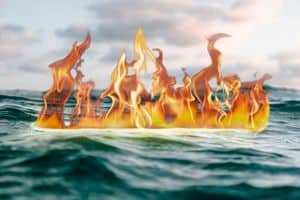When firefighters arrive on the scene to put out a burning blaze, they always use pressurized water. To you, it seems cut and dried that fire couldn’t possibly burn underwater, as water is what’s used to extinguish a fire. A friend of yours disagrees. Can fire indeed burn underwater?

Fire can burn underwater, and welding and construction work can even be done deep into the water’s depths by utilizing the power of fire. With a specialized welding torch, dual hoses can create oxygen gas and a combustible substance so that a fire may burn.
We’re sure this turns everything you know about fires on its head. Don’t worry, as we’ll explain it all so you can understand how fires burn underwater and whether a water-based fire is something you have to worry about in your day-to-day life. Make sure you keep reading!
Table of Contents
How Does a Fire Burn Underwater?
In firefighting, there is what’s known as the fire triangle, which is also known as the combustion triangle. That is, a fire requires three things to sustain itself. They are oxygen, heat, and fuel.
The logic goes that removing one part of the fire triangle eliminates the fire. Keep that in mind as we proceed through this section.
When a firefighter uses a fire hose to blast a fire, it’s not the water that’s eliminating the fire (most people think it is though). It’s the non-flammable gas known as carbon dioxide that displaces the oxygen. Without oxygen, the fire doesn’t burn.
Okay, but there’s no oxygen underwater. That’s why deep-sea divers and snorkelers have to wear oxygen masks. How does a fire burn underwater without oxygen?
Well, it happens in very specific conditions, but it can indeed happen.
Usually, underwater burning is necessary for welding and construction, as we touched on in the intro.
Rather than use the standard blowtorches or welding torches, according to the International Diving Institute, for underwater burning, welders will use a specialized tool.
This welding torch is dual-hosed. One hose can release oxygen gas. The other hose makes a combustible substance.
Now the fire triangle is completed. The fire has oxygen and a fuel source. As the fire burns, the heat it generates can keep it going.
Thus, fire burns underwater!
Do Underwater Fires Last?
If you read our post about testing the weight of fire, we went over how you’d have to start a fire in a small container and then go about a number of calculations to deduce the weight. It was theoretically impossible, at least as of this writing.
The temperament of fire has you wondering how it can possibly burn underwater. It just doesn’t seem like something that can last for more than a second or two.
And yet, it does. It’s not necessarily easy for it to happen, but experienced welders with the right tools can create a sustained fire underwater.
After all, a sustained fire underwater is crucial for burning techniques to occur such as a plasma arc.
According to the International Diving Institute link from before, plasma arcs are used to slice through materials that are considered electrically conductive.
For example, a welder can cut copper, aluminum, or steel at an angle, a curve, or straight via a plasma arc. They need to create a plasma jet at just the right narrowness for the job.
Is an Underwater Fire a Risk?
You had never realized that an underwater fire was a real phenomenon that could occur. Now you’re worried that a fire that begins on land could spread to water and that there would be no refuge.
We can’t say that underwater fires aren’t a risk. In July 2021, the oceans on the Gulf of Mexico did burn. A ruptured pipeline was the cause.

The fire was eventually contained, but the environmental damage was already done.
Outside of instances like what happened on the Gulf of Mexico, a fire burning underwater is an especially rare occurrence.
As we mentioned in the section above, it takes welders and divers with specialty equipment to create a fire underwater. They usually do so to destroy barriers or undertake other construction tasks.
The fires that the diving team creates are contained to just that area. As we touched on, a fire can burn underwater for a sustained period, but the fires are always out by the time the diving team leaves.
The team knows what they’re doing, so the fires don’t rage out of control. That would be a huge threat to the underwater ecosystem.
That’s exactly why you generally shouldn’t worry about underwater fires.
Yes, they can happen, but it’s usually in controlled conditions. A fire doesn’t typically burn underwater because it lacks the oxygen and heat that’s required to do so. You can’t use an average welding tool and create those kinds of conditions.
You need a tool that makes oxygen and a flammable substance. Short of that, a pipeline explosion would have to occur, but that’s not something that anyone wants for the sustainability of our planet and our oceans.
A fire can’t spread from land to the ocean either, as without those specialized conditions, the fire can’t sustain itself. It would burn out when it reached the water.
A fire can burn underwater, which is truly fascinating stuff. However, save for explosions, underwater fires are not something that naturally occurs very regularly.
In most instances of fires burning deep under sea level, a team of welders and divers use specialty tools that create enough oxygen and combustion that a fire can last. Then the team can use techniques such as plasma arcs and water jets for construction purposes.
The next time you see a photo of a fire burning underwater, it’s not Photoshopped and it’s not a hoax. It’s just a rare phenomenon that should certainly be appreciated!